How To Play Long And Short Bunker Shots
Last updated:
Amateurs typically have trouble controlling distance from sand. In my view, this is often because they overcomplicate the issue by bringing in too many variables. In pro-ams I will watch them opening or closing their stance and clubface, or trying to take more or less sand. It’s not a recipe for consistency.
My approach is minimise the differences between a long and short trap shot as far as possible. Ultimately, as I will show you, you should only need to think about one factor to control distance. Using an 8-yard and 35-yard trap shot, I’ll show you how it works.
WHAT STAYS THE SAME…
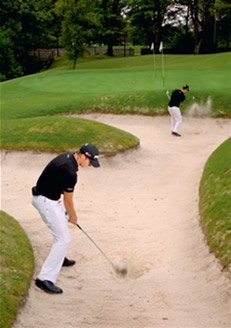 |
#1 Ball positionI always play the ball in the same position in my stance – just forward of centre. This gives me a regular angle of attack whatever the length of the shot – removing one potential source of inconsistent distance control. #2 AlignmentWhatever the length of shot my body aim won’t change – I’ll stand just a little open, aiming a touch left of the target. This gives my swingpath consistency on all trap shots and takes out another unnecessary variable. #3 Clubface loftFor both the 8-yarder and the 35-yarder my clubface stays virtually square – perhaps just a touch open to help the bounce work. Clubface loft clearly has a direct influence on the power transmitted into the ball, so make life easy for yourself by making it a constant. #4 Sand divotThe club will enter the sand maybe a couple of inches behind the ball, irrespective of the length of shot. Just a small difference in sand taken can make a big difference to the power in the ball, so for control it’s much more effective to base your technique around sand divot consistency. |
WHAT CHANGES…
Let pace – and length – of swing be your sole distance controllers.
#1 Shorter shots: crisp up the pace
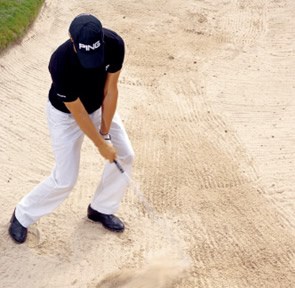
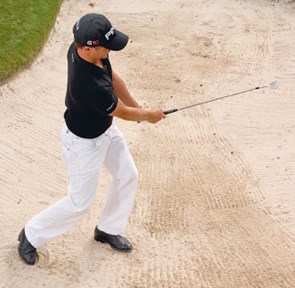
Within a certain distance range – say 7-20 yards – I’ll keep my swing a uniform length and simply adjust the pace of my swing. My action simply becomes speedier and more purposeful as the shot gets a little longer. My feeling through impact is of hitting down into the sand and sending the club under the ball – almost like a short lob shot. Although the clubhead may overtake the hands, this is never a flicky motion.
On these shorter shots my followthrough will tend to finish no further than the club’s butt opposite my navel, even with a pacy, crisp action. The face is held open to the finish. This pace-driven approach works especially well on shorter shots because with a more aggressive action you can hit down into the sand harder and pop the ball up quicker, with plenty of check – often what you need when the pin is close.
#2 Longer shots: add length to your swing
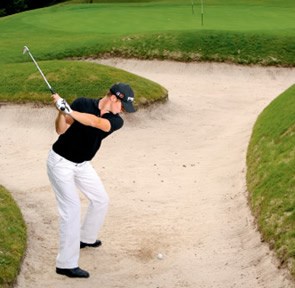
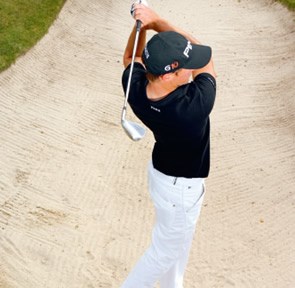
Naturally, you’ll reach a length of trap shot where even your most purposeful short-length swing can’t send the ball far enough. So from 20-40 yards I’ll look to keep the pace of swing the same – not slow, not fast – and simply increase its length to add distance. On this shot – a 35-yarder – I’m almost at full-swing length.
With swing length governing distance, it’s important your tempo stays smooth and consistent. The best way to do that is to marry up backswing and throughswing lengths. On this longer shot, my finishing position mimics the backswing length – just short of full.
Whether it’s controlling shorter shots through pace or longer shots through swing length, my approach means you are only dealing with one adjustment at any one time – and that’s as simple as your approach can get.


